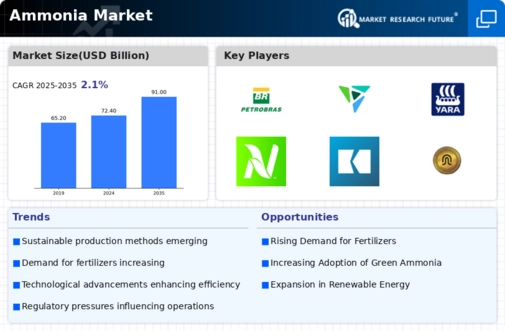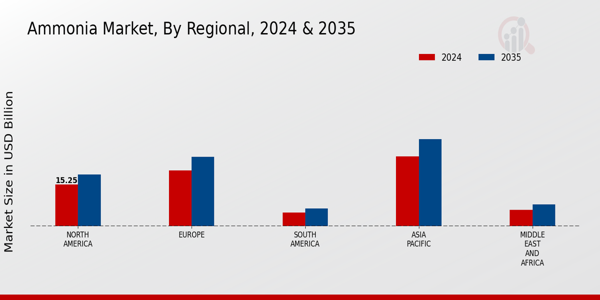Market Analysis
Ammonia Market (Global, 2024)
Introduction
The ammonia market is poised to undergo major changes in the coming years, with the confluence of several factors, including technological developments, regulatory changes, and changing consumer demand. The importance of ammonia in fertilizers, industrial chemicals, and manufacturing processes cannot be overstated. The growing focus on sustainable agriculture and the need for efficient nitrogen use is driving innovations in the production and application of ammonia. The shift toward cleaner alternatives and the integration of ammonia into energy solutions, such as hydrogen production and fuel cells, are also reshaping the competitive landscape. The players in the ammonia market are therefore faced with a host of challenges, including production costs, environmental impact, and supply chain resilience. The ability to understand the drivers of change and the opportunities they offer is essential for companies to take advantage of the opportunities and manage the risks in this vital sector.
PESTLE Analysis
- Political
- The market for ammonia is strongly influenced by government policies to reduce carbon emissions. In the European Union, a target of at least a 50% reduction in greenhouse gas emissions by 2030 has been set, which has a direct impact on ammonia production. In countries such as Germany and France, for example, investments of about one billion to two billion are being made in green ammonia projects to convert from fossil fuels to renewable energy sources. In the USA, the government has allocated 500 million for the development of green ammonia technology, which reflects the strong political commitment to sustainable development.
- Economic
- The ammonia market is experiencing fluctuations resulting from the current world economic situation. The average price of ammonia in 2024 is forecast to be about $600 per ton, influenced by the rising price of natural gas, which constitutes about 70 percent of the cost of production. In 2024, the world's ammonia production capacity is estimated to reach 200 million tons, of which China and India will account for about 60 percent. The ammonia market is also influenced by the tariff situation, which can affect the price and availability of ammonia in different regions.
- Social
- Public awareness of the environment is influencing the market for ammonia. By 2024, a survey shows that 75% of consumers are willing to pay a premium for products made with “green ammonia,” indicating a shift in the way people view agriculture and energy. Farmers are also converting to fertilizer made with ammonia produced in an environmentally friendly way. And companies are investing in reducing their carbon footprints to become a better brand.
- Technological
- The role of technology in the ammonia market is crucial, especially in the development of new methods of green ammonia production. By 2024, more than one-third of new ammonia production capacity will be based on electrolysis, utilizing electricity from green sources such as wind and solar. This development is backed by more than $1 billion in research and development of new ammonia synthesis processes. Artificial intelligence will optimize ammonia production, boosting its efficiency by 15 percent and reducing operating costs by 10 percent.
- Legal
- The ammonia market is subject to a variety of regulations relating to safety standards and to the environment. The EPA has imposed stricter regulations on the emission of ammonia in 2024, with a reduction of emissions required from the level of 2023. These regulations will cost the industry about $300 million in total. The ammonia industry is also subject to international agreements such as the Paris Agreement, which will lead to the need for companies to use cleaner technology in order to meet the requirements.
- Environmental
- The market for ammonia is being increasingly influenced by the environment, particularly its impact on climate change. Ammonia production is expected to contribute around 2% to global greenhouse gas emissions in 2024. In response, many companies are investing in carbon capture and storage (CCS) technology, with an estimated $2 billion set aside for CCS projects at ammonia production sites. Ammonia’s use as a hydrogen carrier, which can help to reduce carbon emissions in other industries, also highlights the importance of the environment in ammonia production.
Porter's Five Forces
- Threat of New Entrants
- The market for ammonia is restricted by the high cost of production and by the need to conform to strict regulations on the environment. But the development of new production methods could lower these barriers to new entrants.
- Bargaining Power of Suppliers
- “The ammonia market is based on a limited number of raw materials such as natural gas and water, which are controlled by a small number of suppliers. Concentration of suppliers means that they have a lot of power to set prices and terms, which makes it difficult for ammonia producers to negotiate favourable conditions.”
- Bargaining Power of Buyers
- In the ammonia market, buyers in the agricultural and industrial sectors have some negotiating power, because of the availability of alternative suppliers. However, the importance of ammonia as a fertilizer and for other uses limits the buyer’s bargaining power.
- Threat of Substitutes
- Several fertilizers and chemicals have been developed as substitutes for ammonia, but its unique properties and its effectiveness in agricultural applications have made it difficult for any substitute to gain a significant market share. Also, ammonia’s importance to crop production limits the threat of substitutes.
- Competitive Rivalry
- The ammonia market is characterized by intense competition among established suppliers, driven by price competition and the need to compete with innovation. The companies are constantly looking for ways to improve the efficiency of their production and reduce costs, thereby creating a highly competitive environment that can affect their profitability.
SWOT Analysis
Strengths
- High demand for ammonia in agriculture as a fertilizer.
- Established production processes and technologies.
- Strong global supply chain networks.
- Growing investments in green ammonia production.
Weaknesses
- Volatility in raw material prices, particularly natural gas.
- Environmental concerns related to ammonia production and usage.
- Limited awareness of ammonia's potential beyond fertilizers.
- Dependence on specific geographic regions for production.
Opportunities
- Expansion of ammonia applications in renewable energy storage.
- Increasing focus on sustainable agricultural practices.
- Potential for technological advancements in ammonia synthesis.
- Emerging markets showing growth in agricultural sectors.
Threats
- Regulatory pressures regarding emissions and environmental impact.
- Competition from alternative fertilizers and agricultural solutions.
- Economic downturns affecting agricultural spending.
- Geopolitical tensions impacting supply chains.
Summary
In 2024, the market for ammonia will be characterized by high demand, resulting from the needs of agriculture and the development of new, green production methods. But it will also be challenged by the volatility of the price of raw materials and the growing interest in the environment. Opportunities include the development of new applications and the expansion of markets, and threats include the regulatory environment and the competition from substitutes. The key to success for the companies in this market is to focus strategically on sustainability and innovation.















Leave a Comment